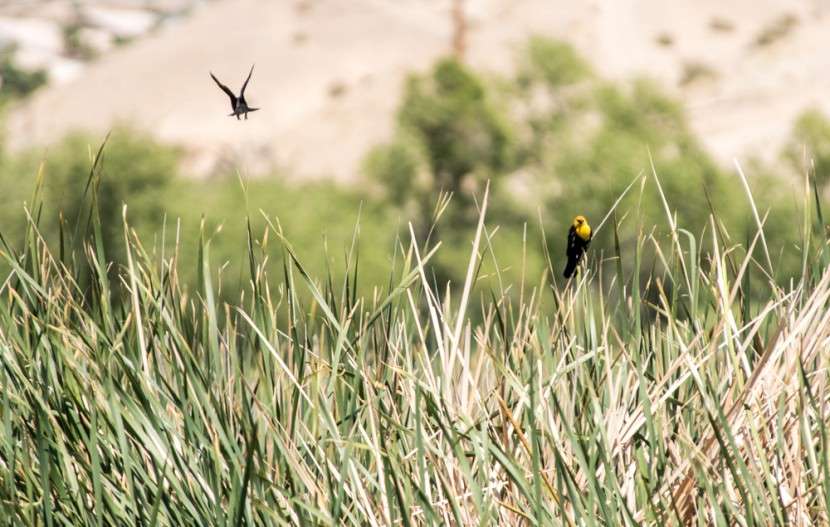
LAKE HAVASU CITY, Ariz. — Aaron Martens, who has previously won bass tournaments on a dragonfly pattern at Lake Havasu, took it to another level here last week. Yes, the big story was how Martens looked to blackbirds for clues on how to win the Bassmaster Elite at Lake Havasu presented by Dick Cepek Tires and Wheels.
The way Martens' mind flits like a bird, especially when he's on the weigh-in stage with emcee Dave Mercer, the blackbird pattern may have seemed like some sort of joke. Martens hopes everyone continues to think of it that way.
"It's for real," said the 42-year-old two-time Toyota Bassmaster Angler of the Year. "I shouldn't even be talking about it. I've known that for 25 years, that (bass) eat birds. I've caught 'em in California, and they've spit up full-grown blackbirds in my livewell.
"They eat birds. It's part of their diet. They're river bass. They're real mean."
This was obviously no joke. Martens went on to explain the details of how he exploited the blackbird pattern. First, of course, you have to have that basic awareness that wherever birds are nesting in the thick, tall tules of Lake Havasu, there might be some big bass cruising underneath, looking for an easy meal.
"I pay attention to everything," Martens said, "if there's anything around that can possibly give me a clue. (Saturday) I noticed the birds back in there nesting and buzzing back and forth to feed their babies. That got me excited. That's how I caught 'em (Saturday). I'm like, they're eating birds!"
Then, when you find blackbird feathers in your livewell the next morning, like Martens did Sunday at Lake Havasu, you can feel confident you're on to something.
Finally, let Martens tell you the subtleties of exploiting that pattern. He had three 4-pounders in his winning bag of 19-5 Sunday: a 4-14, which was the big bass of the day, a 4-10 and a 4-8. This was a tournament where the average bass weighed-in was 2 3/4 pounds, so a 4 1/2-pounder, or better, was a difference maker.
"You don't want to go back in there too early," Martens said. "They can't see real good. It's like a jungle. There's almost no holes. You make a 50-foot pitch back in there. If you hear it hit the water, you're good."
Martens, who some still consider Mr. Finesse even thought he does everything well, was using a 7-foot, 6-inch extra heavy Enigma rod, which he designed, with an 8.5 to 1 gear ratio reel. No finesse.
"That reel was real important because once you got 'em, you had to keep 'em coming," he said.
A 3/4-ounce weight anchored with two bobber stoppers to a 4/0 Heavy Cover Gamakatsu hook was the structure for his lure. Martens added a green-pumpkin punch skirt and either a Strike King Rage Craw or a Zoom Speed Craw tied to 30-pound test Sunline SX-1 braided line.
"It would have been nice to go to a one-ounce weight," he said. "A half-ounce was too light. Three-quarters was about right."
Martens noticed fish occasionally bit, then dropped the 3/4-ounce weight, which ruled out going to anything heavier. It's another example of Martens' uncanny attention to detail.
Martens said that he and Edwin Evers, who finished third and led on Day 1 with a 20-pound bag, shared water all four days. They were in the thick vegetation just up the Colorado River from the main lake.
In reference to Martens' blackbird pattern, Evers smiled and said the bass he caught were eating crawfish and he was dyeing the tails of his baits to match the crawfish colors. But Evers did catch a smallmouth bass on a topwater frog during the tournament, which is rare. Most likely Martens and Evers were sharing "mean, river bass" that were eating anything that moved, whether it had pincers, fins, feathers or frog legs.
And what about those dragonflies? The topic got started with Martens after David Walker told a story about several failed attempts to catch a bass with a jig. Walker could see the fish in Lake Havasu's clear water, but the fish appeared particularly uninterested in Walker's half-ounce jig. It swam away and stopped under an overhanging tree limb.
So Walker made one more cast and was shocked by what he saw. The fish came out of the water about a foot and engulfed Walker's jig in the air.
"I've never seen that before," Walker said. "It was a good fish too. It was one I weighed-in."
Martens, of course, had an explanation. It's a little early for the dragonfly pattern on Lake Havasu, but it's a productive summer pattern here.
"When it gets a little hotter, the bigger dragonflies start thumping the water and bass will actually chase 'em and blast 'em," Martens said. "If you can get a buzzbait in there at the same time, it works good. I've actually won tournaments here on dragonfly patterns.
"You just look in the backs of the little shallow bays. You'll see multiple boils on a dragonfly."
Aaron Martens naturally comes by his awareness of everything in nature.
"I got fortunate growing up," he said. "I was around a lot of the outdoors. My nickname in the neighborhood was 'Nature Boy.'"
Martens said he'd pick up everything from rattlesnakes to bugs, when he was running barefoot through his neighborhood. He probably prefers his newest nickname, "Hawg Snatcher," over "Nature Boy."
Both fit. He's Aaron Martens – the most interesting man in bass fishing.




